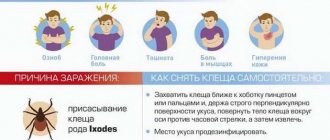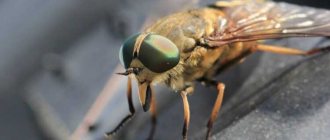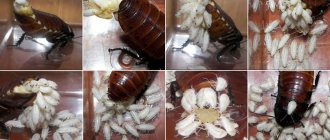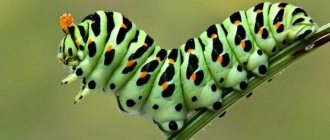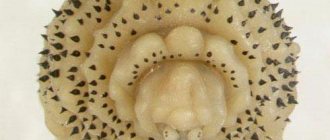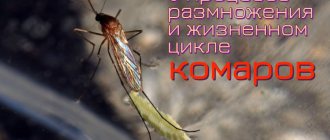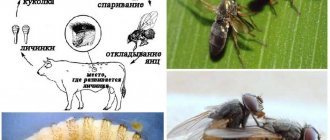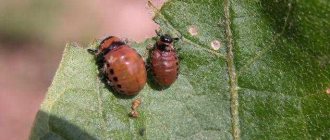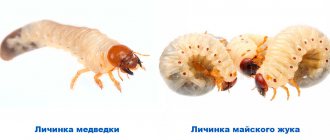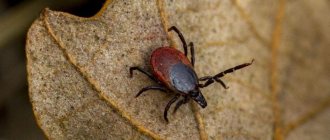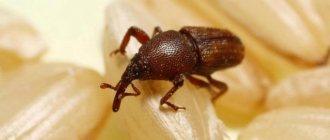- Wild animals
- >>
- Insects
The malaria mosquito is the most dangerous representative of the mosquito family and the hero of various frightening stories. It lives in many countries and is capable of transmitting not only allergens, but also malaria, which causes the death of up to half a million people every year. In our latitudes, many do not know what this creature with a tarnished reputation looks like, and often mistake the harmless long-legged mosquito for malarial, while it is absolutely harmless to humans.
What does a malaria mosquito look like?
To protect yourself from attacks and dangerous consequences of insect bites, it is worth knowing what a malaria mosquito looks like. The parasite is no different from ordinary bloodsuckers, this is their danger.
Malaria mosquitoes have another name: Anopheles mosquitoes. They belong to the genus of dipterous insects. The general development cycle includes several stages - egg-larva-pupa-imago.
The larvae have a clearly visible head. There are special brushes on the surface that are intended for eating food. The larvae have an expressive chest and abdominal zone, which consists of several segments.
On the eighth of them there are spiracles through which air enters. For this reason, the larvae are not able to stay under water for a long time; they periodically float to the surface for a new portion of air.
Gradually, the larva transforms into a pupa state, which from the outside resembles a comma. She does not have a separate head or chest, all parts merge. She breathes like a larva. She inhales using tubes that are located on the surface of the head.
After some time, an adult individual, the imago, emerges from the pupa. It has an elegant elongated body with a fragile structure. Thin legs are attached to the body. The head is small in size; there is a long proboscis on it, which, when not working, lies directly on the abdominal area.
What do Anopheles eat?
Females of this type of insect consume blood, but not always, for example, after laying eggs, they prefer to consume flower nectar, so this period can be considered as safe as possible for a potential victim of bloodsuckers.
After biting a person with malaria, the malaria mosquito becomes its carrier. The mosquito is the main host, and vertebrates are intermediate hosts for the parasite.
Scientific classification
According to research conducted in 2004, Anopheles belongs to the genus
which is divided into 6 subgenera:
- Cosmopolitan Anopheles. It unites 189 species;
- It includes 239 species that live in the tropics of the Old World;
- Four neotropical subgenera – Kerteszia (12 species), Lophopodomyia (6), Nyssorhynchus (33), Stethomyia (5 species);
- Two fossil subgenera are known from Oligocene deposits - (Germany, Anopheles rottensis) and from Dominican amber (Anopheles dominicanus).
Enemies in nature
Anopheles have a fairly large number of natural enemies; they are destroyed by leeches, snails, various worms, and all aquatic insects.
In addition, arthropod larvae are the favorite food of frogs and fish, which is why they die in huge numbers at this stage, before they have time to develop. Birds that live near the surface of water bodies do not neglect them either.
It should also be noted that there are varieties of vegetation that prey on adults, but they can only be found in tropical latitudes.
Larva
The larva of the malaria mosquito is formed from eggs laid by the female. It resembles a caterpillar or worm. Its surface has a greenish tint, its body length is only 8 mm.
The head is small in size, but at the same time it is well developed. It has oral brushes that the creature uses for feeding. There is also a chest and abdomen, divided into segments. There are no limbs.
Compared to other types of mosquitoes, the larvae of malaria bloodsuckers do not have a respiratory siphon, so they float on the water parallel to the surface. They breathe using spiracles, which are located on the eighth segment.
They periodically float to the surface for a new portion of air.
Insecticide resistance
Insect control measures Insecticides (spraying) are the main way to kill mosquitoes that bite indoors. After prolonged exposure to an insecticide, insects may develop resistance, the ability to survive contact with it.
Because mosquitoes have many generations per year, high levels of resistance arise very quickly. There are more than 125 species of mosquitoes with documented resistance to one or more insecticides.
Female
Malaria mosquitoes prefer to feed on blood; their diet also includes vegetation and plant sap. It is worth considering that only females drink blood; they use it to maintain full vital functions and for reproduction. But males do not attack people or animals; they consume only plant foods, plant nectar.
Females have a larger body than males, they are larger . Male and female individuals have antennae on the surface of the head, only in males they are equipped with processes and look like lush mustaches. But in females they are sensitive, capable of detecting heat from a mammal several kilometers away.
The purpose of female anopheles is to procreate. For these purposes, individuals use the blood of people and animals. After fertilization they lay eggs. After some time, larvae are formed from the eggs of the female malaria mosquitoes, they look like worms, then pupae appear, from which the imago is formed.
Diet and rest patterns
Most Anopheles mosquitoes are crepuscular (active at dusk or dawn) or nocturnal. Some feed indoors (endophagy), others outdoors (exophagy).
Find out more Life expectancy of a mosquito: where do they come from, what do they eat, why are they needed
Endophilic species are easily controlled by spraying residual insecticides. Exophagic, exophilic are best controlled by source reduction (destruction of larval habitat).
Where do malaria mosquitoes live?
Still, many may be interested in where malaria mosquitoes live, since they are considered dangerous insects because they can spread malaria. You can meet bloodsuckers in every corner of the Earth. They may be absent in cold areas.
The malaria mosquito in Russia can be found in European regions and Western Siberia. Due to the fact that unfavorable climatic conditions are observed in the regions of Eastern Siberia, Anopheles does not live in this part of the Russian Federation.
It is important for representatives of the Anopheles species to have bodies of water nearby. This is required for full reproduction. During the summer season, bloodsuckers cause severe damage to residents of the Republic of Tatarstan and the city of Kazan.
Individuals live in the Far East. But the climatic conditions of the region do not allow the malarial plasmodium to complete its life cycle. This prevents the spread of malaria.
Anopheles is found most often in tropical countries. They have a high mortality rate from malaria. It happens that bloodsuckers of this species are found in regions where the disease has been defeated.
Danger to life from human health
External signs of malaria
- Scientists from many disciplines are working to study the diseases that malaria mosquitoes carry. The first most common is malaria. In African countries, it claims more than a million children's lives every year. The main carriers of tropical malaria are females of the species Anopheles gambiae.
- The second largest group of diseases caused by a large number of threadworms. Absorbed into the blood of an infected person (with many microscopic worms) through the mouth, the mosquito transfers them to healthy people. As a result, they clog blood vessels, form blood clots, and promote the accumulation of lymph in the arms or legs, which causes them to swell to enormous sizes—elephantiasis develops. The countries of South America, Asia and Africa are “record holders” for the number of deaths from these diseases.
- Another group of diseases that are caused by the bite of a malarial mosquito is encephalitis, yellow and tropical fever. This group is characterized by infections with microbes and viruses.
Interesting Facts
Malaria mosquitoes are fraught with many interesting and secret things.
We know little about them, but the facts below can reveal many secrets.:
- Anopheles is included in the Guinness Book of Records. It is considered the most dangerous insect on Earth;
- They are carriers of a dangerous disease - malaria. Every year, 200 million people die from it on the planet;
- Bloodsuckers of the Anopheles species are found where there are foci of malaria. In other areas, encountering them is very rare;
- The insect's flight speed is 3.2 km/hour;
- Females are larger than males. The body size of insects is 12.5-13 mm. However, there is evidence that previously there were huge individuals with a body length of 5 cm;
- Unlike ordinary mosquitoes, Anopheles mosquitoes have a slightly raised back part of their body. They also move parallel to the surface;
- Insects see through the prism of an infrared beam, so they can quickly find people and animals even in complete darkness;
- To get enough, mosquitoes can fly long distances (up to 65 kilometers);
- In 1 second, an insect flaps its wings 600 times. This is what creates the unpleasant sound that comes from mosquitoes - squeaking;
- According to scientific research, it has been found that mosquitoes often attack people who are very sweaty. They find the victim by body odor and exhaled carbon dioxide;
- The development cycle from egg to adult is only 4 days;
- Mosquitoes are nocturnal insects and this is when they begin to attack. Their activity increases by almost 500% during the full moon.
Malaria. Is she really that scary?
But what’s so scary about this very malaria? Just think, it will just itch a little and that’s all. Unfortunately, it's not that simple. Malaria or swamp fever is an infectious disease. It is very severe and is accompanied by chills, fever, changes in the size of the liver and spleen, as well as anemia. This disease is indeed most common in Africa and affects mainly children under 5 years of age.
Of the 500 million people who contracted malaria at the beginning of the 21st century, approximately 3 million died. The current vaccine shows effectiveness in the range of 31-56%. We especially note that the disease is very insidious and can return again and again even after complete recovery.
Interesting! It is malaria that is considered the main cause of the fall of the Roman Empire in the 5th century. True, not all at once, but only the Western Empire. Until recently, this was just a beautiful hypothesis. But not so long ago, scientists examined the remains of 58 people who lived at that time. In two samples, DNA fragments were found that clearly indicate that these Romans suffered from malaria and probably died from it. Moreover, we are talking about the most severe form of the disease, which is caused by Plasmodium falciparum.
Do you know what is the most offensive? The ancient Romans paid for their thirst for progress in this way. Outbreaks of the disease were directly related to the fact that in order to build new roads, they tried to drain the swamps. Apparently the mosquitoes didn't like it much.
Life cycle
The development cycle of the malaria mosquito covers several stages:
- Egg;
- Larva;
- Pupa;
- Imago or adult individual.
For full reproduction, insects require the presence of nearby bodies of water. After fertilization, the female lays eggs on the surface of the water. It is here that the main development of future offspring is observed.
On average, the period of maturation from egg to adult is from 4 days to 2 weeks. The malaria mosquito can remain in the adult stage for several months.
The period of development can be indicated by various conditions - climate, water temperature, availability of sufficient food. There must be normal lighting, a suitable temperature, and moderate humidity.
Symptoms of bites
It all starts like this - you need to see a doctor immediately
The main symptom of a malaria mosquito bite is fever, even if a small amount of infected parasites has entered the bloodstream. Malaria has 4 forms (tropical, three-day, four-day, oval) with individual characteristics. The disease is divided into three stages, they all have their own symptoms.
- During the first latent period there is an acute manifestation of the disease and relapses, headache, chills.
- The second stage is characterized by chills, fever, rapid pulse, and convulsions. At the end of the stage, the temperature drops sharply and profuse sweating appears. During attacks, all internal organs suffer and begin to “fail.” After 15 such attacks, the infection gradually subsides.
- During the second latent period, relapses may occur if improper treatment is given.
Symptoms of the disease such as headache, fever, chills, and significant sweating are inherent in all forms of malaria, but each has its own characteristics.
Thus, the duration of tropical malaria is from six months to a year. Three-day malaria, in addition to general symptoms, has attacks alternating every other day, which begin in the first half of the day. This disease lasts 2-3 years. The long course of the disease is quartan malaria, accompanied by attacks every two days. Oval is one of the lightest shapes. It may go away within two weeks, but generally lasts 3-4 years. Attacks occur every other day, in the evening.
Biological features
Malaria mosquitoes are dipterous insects that are practically no different from ordinary mosquitoes. The insect has a long and thin body, the size of which is 6-14 mm. The body color is dark gray or brown. There is a pair of transparent wings on the surface. The body is divided into distinct small segments. Stripes can be seen on the surface of the back.
The insect's head is small in size and has eyes on its surface. They have a scalloped structure and consist of many ommatidia . There are antennae on the front surface of the head. They provide smell recognition, and insects also use them for touch. Males have long and fluffy hairs on their antennae, while females have short and sparse hairs.
Insects have a pair of wings; they have an elongated oval shape. The surface has a large number of transverse and longitudinal veins, covered with microtrichia (small hairs). Malaria mosquitoes have 4 brown spots on the surface of their wings.
Oral apparatus
The oral apparatus of malaria mosquitoes is a kind of proboscis.
It has the following parts:
- Upper and lower lip;
- Hypopharynx (subpharynx);
- A pair of upper jaws - mandibles;
- Pair of lower jaws - maxillary.
The lower lip is a tube. It is a support for stabbing stilettos. It is through this that blood passes during suction. As mentioned above, only females consume blood; they use it for full life activity and reproduction. It is considered a nutritional component for egg maturation.
5-segmented palps are used as organs of touch and taste, which extend from the base of the jaws. In malaria mosquitoes, the palps and proboscis are of equal length, and club-shaped thickenings are provided at the ends.
Treatment
After determining the type of mosquito, the doctor will prescribe treatment. Nowadays, to combat malaria they use:
- quinine;
- combination drugs with artemisinin;
- annual wormwood extract (Artemisia annua).
In some cases, annual wormwood extract is used to treat malaria.
This is interesting! The first one-time drug to combat malaria was developed at the University of Texas Medical Center. However, it is still in the testing stage.
